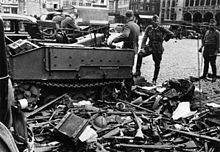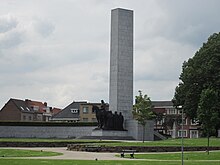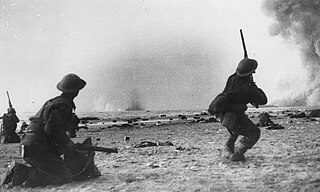
The Battle of Dunkirk was fought around the French port of Dunkirk (Dunkerque) during the Second World War, between the Allies and Nazi Germany. As the Allies were losing the Battle of France on the Western Front, the Battle of Dunkirk was the defence and evacuation of British and other Allied forces to Britain from 26 May to 4 June 1940.

The Dunkirk evacuation, codenamed Operation Dynamo and also known as the Miracle of Dunkirk, or just Dunkirk, was the evacuation of more than 338,000 Allied soldiers during the Second World War from the beaches and harbour of Dunkirk, in the north of France, between 26 May and 4 June 1940. The operation commenced after large numbers of Belgian, British, and French troops were cut off and surrounded by German troops during the six-week Battle of France.

The First Battle of Ypres was a battle of the First World War, fought on the Western Front around Ypres, in West Flanders, Belgium. The battle was part of the First Battle of Flanders, in which German, French, Belgian armies and the British Expeditionary Force (BEF) fought from Arras in France to Nieuwpoort (Nieuport) on the Belgian coast, from 10 October to mid-November. The battles at Ypres began at the end of the Race to the Sea, reciprocal attempts by the German and Franco-British armies to advance past the northern flank of their opponents. North of Ypres, the fighting continued in the Battle of the Yser (16–31 October), between the German 4th Army, the Belgian army and French marines.
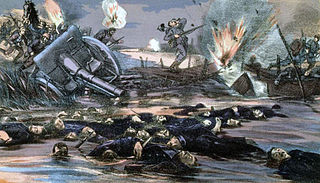
The Battle of the Yser was a battle of the First World War that took place in October 1914 between the towns of Nieuwpoort and Diksmuide, along a 35 km (22 mi) stretch of the Yser River and the Yperlee Canal, in Belgium. The front line was held by a large Belgian force, which halted the German advance in a costly defensive battle.

The Battle of the Lys, also known as the Fourth Battle of Ypres, was fought from 7 to 29 April 1918 and was part of the German spring offensive in Flanders during the First World War. It was originally planned by General Erich Ludendorff as Operation George but was reduced to Operation Georgette, with the objective of capturing Ypres, forcing the British forces back to the Channel ports and out of the war. In planning, execution and effects, Georgette was similar to Operation Michael, earlier in the Spring Offensive.

The Vinkt massacre was a war crime committed by German soldiers in the villages of Vinkt and Meighem in East Flanders on 26–28 May 1940 during the Battle of the Lys. Between 86 and 140 civilians were deliberately killed by Wehrmacht troops from the 377th Infantry Regiment of the 225th Infantry Division, supposedly in retaliation for the Belgian Army's resistance in the village.

The Bataillon de Chasseurs Ardennais is an infantry formation in the Land Component of the Belgian Armed Forces. Originally formed in 1933 to ensure the defense of Belgium's Luxembourg Province including the natural region of the Ardennes and particularly noted for its role during the German invasion of 1940, the unit currently serves as a mechanized infantry formation and forms part of the Motorized Brigade.
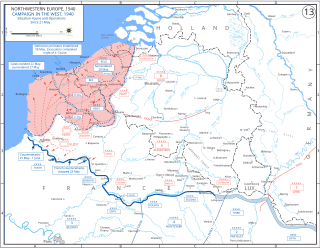
The siege of Lille or Lille pocket took place during the Battle of France in the Second World War. The siege of the French IV Corps and V Corps of the First Army was conducted by four German infantry divisions supported by three panzer divisions.
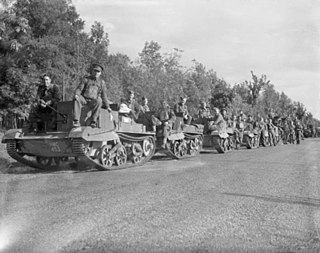
The British Expeditionary Force (BEF) was the contingent of the British Army sent to France in 1939 after Britain and France declared war on Nazi Germany on 3 September, beginning the Second World War. The BEF existed from 2 September 1939 when the BEF GHQ was formed until 31 May 1940, when GHQ closed down and its troops reverted to the command of Home Forces. During the 1930s, the British government had planned to deter war by abolishing the Ten Year Rule and rearming from the very low level of readiness of the early 1930s. The bulk of the extra money went to the Royal Navy and the Royal Air Force but plans were made to re-equip a small number of Army and Territorial Army divisions for service overseas.

The invasion of Belgium or Belgian campaign, often referred to within Belgium as the 18 Days' Campaign, formed part of the larger Battle of France, an offensive campaign by Germany during the Second World War. It took place over 18 days in May 1940 and ended with the German occupation of Belgium following the surrender of the Belgian Army.
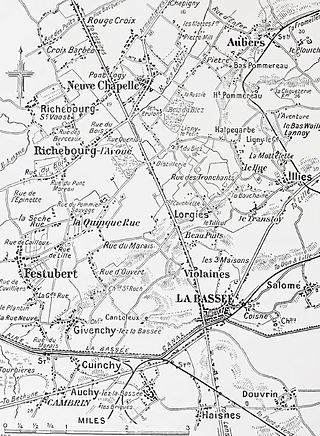
The Battle of La Bassée was fought by German and Franco-British forces in northern France in October 1914, during reciprocal attempts by the contending armies to envelop the northern flank of their opponent, which has been called the Race to the Sea. The 6th Army took Lille before a British force could secure the town and the 4th Army attacked the exposed British flank further north at Ypres. The British were driven back and the German army occupied La Bassée and Neuve Chapelle. Around 15 October, the British recaptured Givenchy-lès-la-Bassée but failed to recover La Bassée.

The Battle of Armentières was fought by German and Franco-British forces in northern France in October 1914, during reciprocal attempts by the armies to envelop the northern flank of their opponent, which has been called the Race to the Sea. Troops of the British Expeditionary Force (BEF) moved north from the Aisne front in early October and then joined in a general advance with French troops further south, pushing German cavalry and Jäger back towards Lille until 19 October. German infantry reinforcements of the 6th Army arrived in the area during October.

The Battle of Boulogne in 1940 was the defence of the port of Boulogne-sur-Mer by French, British and Belgian troops in the Battle of France during the Second World War. The battle was fought at the same time as the Siege of Calais, just before Operation Dynamo, the evacuation of the British Expeditionary Force (BEF) from Dunkirk. After the Franco-British counter-attack at the Battle of Arras on 21 May, German units were held ready to resist a resumption of the attack on 22 May. General der Panzertruppe (Lieutenant-General) Heinz Guderian, the commander of XIX Corps, protested that he wanted to rush north up the Channel coast to capture Boulogne, Calais and Dunkirk. An attack by part of XIX Corps was not ordered until 12:40 p.m. on 22 May, by which time the Allied troops at Boulogne had been reinforced from England by most of the 20th Guards Brigade.
The Battle of the Ypres–Comines Canal was a battle of the Second World War fought between the British Expeditionary Force (BEF) and German Army Group B during the BEF's retreat to Dunkirk in 1940. Part of the Battle of Belgium and the much larger Battle of France, it started in the afternoon of 26 May and reached its maximum intensity on 27 and 28 May. Locally it is referred to as the Battle of the Canal and it is sometimes incorrectly referred to as the Battle of Wytschaete. Its official British Army name, which is borne on the battle honours of a number of regiments, is that given here.

The siege of Ypres saw a Republican French army commanded by Jean-Charles Pichegru invest the fortress of Ypres and its 7,000-man garrison composed of Habsburg Austrians under Paul von Salis and Hessians led by Heinrich von Borcke and Georg von Lengerke. French troops under Joseph Souham fended off three relief attempts by the corps of François Sébastien Charles Joseph de Croix, Count of Clerfayt. Meanwhile, the French besiegers led by Jean Victor Marie Moreau compelled the Coalition defenders to surrender the city. The fighting occurred during the War of the First Coalition, part of the Wars of the French Revolution. In 1794 Ypres was part of the Austrian Netherlands, but today it is a municipality in Belgium, located about 120 kilometres (75 mi) west of Brussels.
The 4th Infantry Division(4de Infanterie Divisie) was an infantry division of the Belgian Army that existed until the Battle of Belgium during the Second World War.
The 225th Infantry Division was an infantry division of the German Heer during World War II.
The 9th Infantry Division was an Infantry Division of the Belgian Army that fought in the Battle of Belgium during the Second World War.
The 15th Infantry Division(15de Infanterie Divisie) was an infantry division of the Belgian Army that fought in the Battle of Belgium against the Wehrmacht during the Second World War.

Operation David was the codename for the deployment of the British Expeditionary Force (BEF) into Belgium at the start of the Battle of Belgium during the Second World War. On the same day as the German invasion of neutral Belgium, 10 May 1940, the BEF moved forward from their prepared defences on the Franco-Belgian border to take up a new position deep inside Belgium, conforming to plans made by the French high command. Forming a defensive line with French and Belgian forces on either side, the BEF were able to contain attacks by German infantry divisions, but were unaware that this was a diversion; the main thrust by highly mobile German armoured divisions was further south. To avoid complete encirclement, the BEF and their allies were forced into a series of fighting retreats and ended up back at their initial border positions by 24 May. However, the German spearhead had reached the coast behind them, cutting them off from their supply chain and leading to the Dunkirk evacuation of the BEF in the following days.



